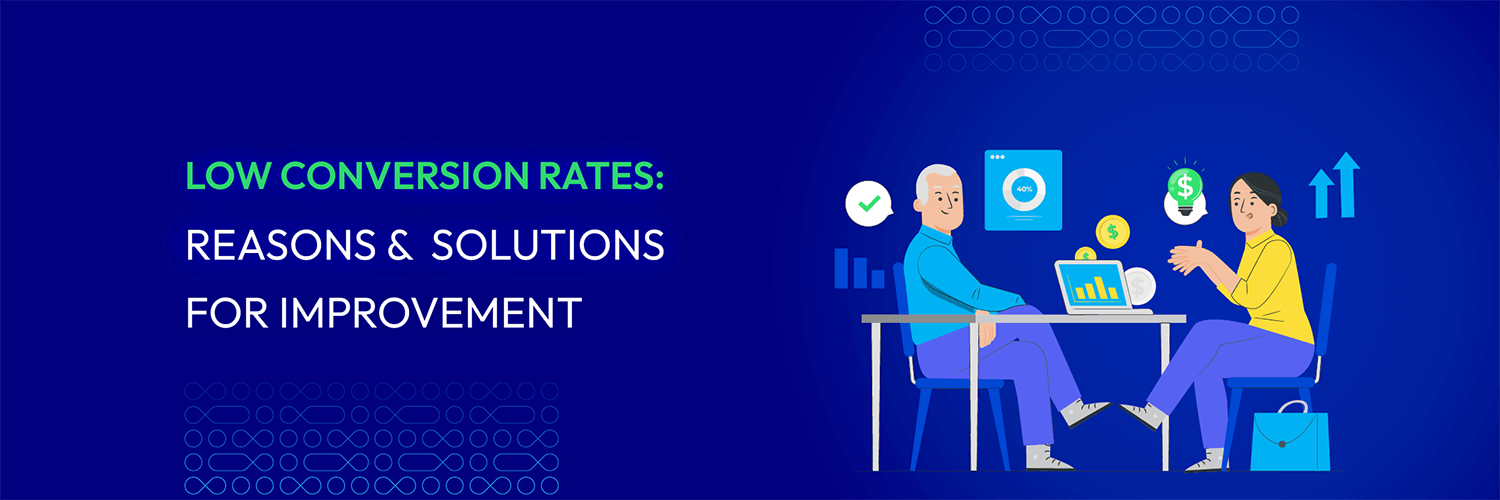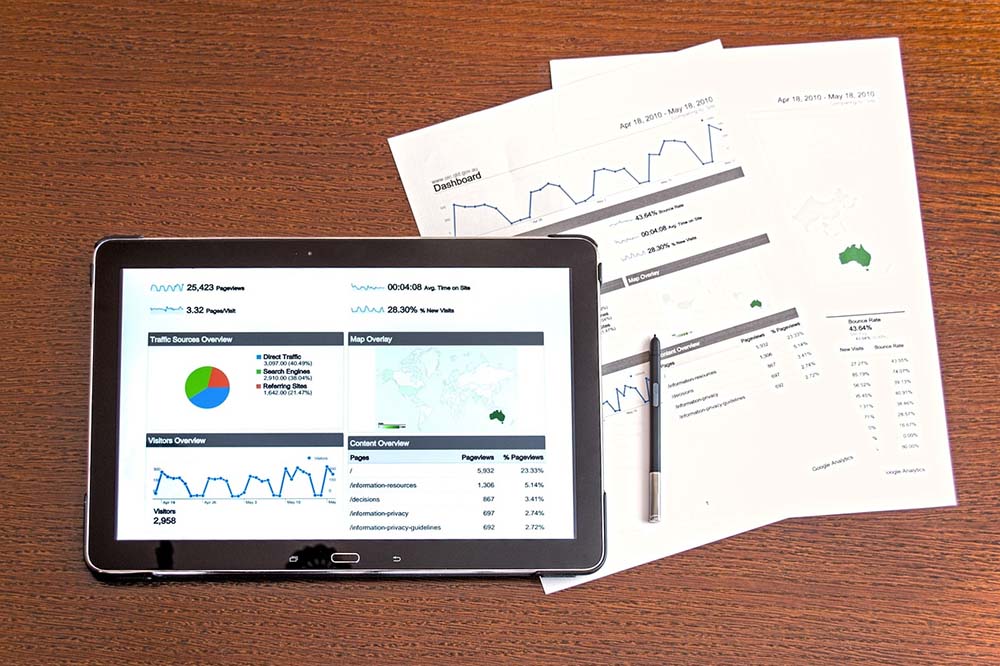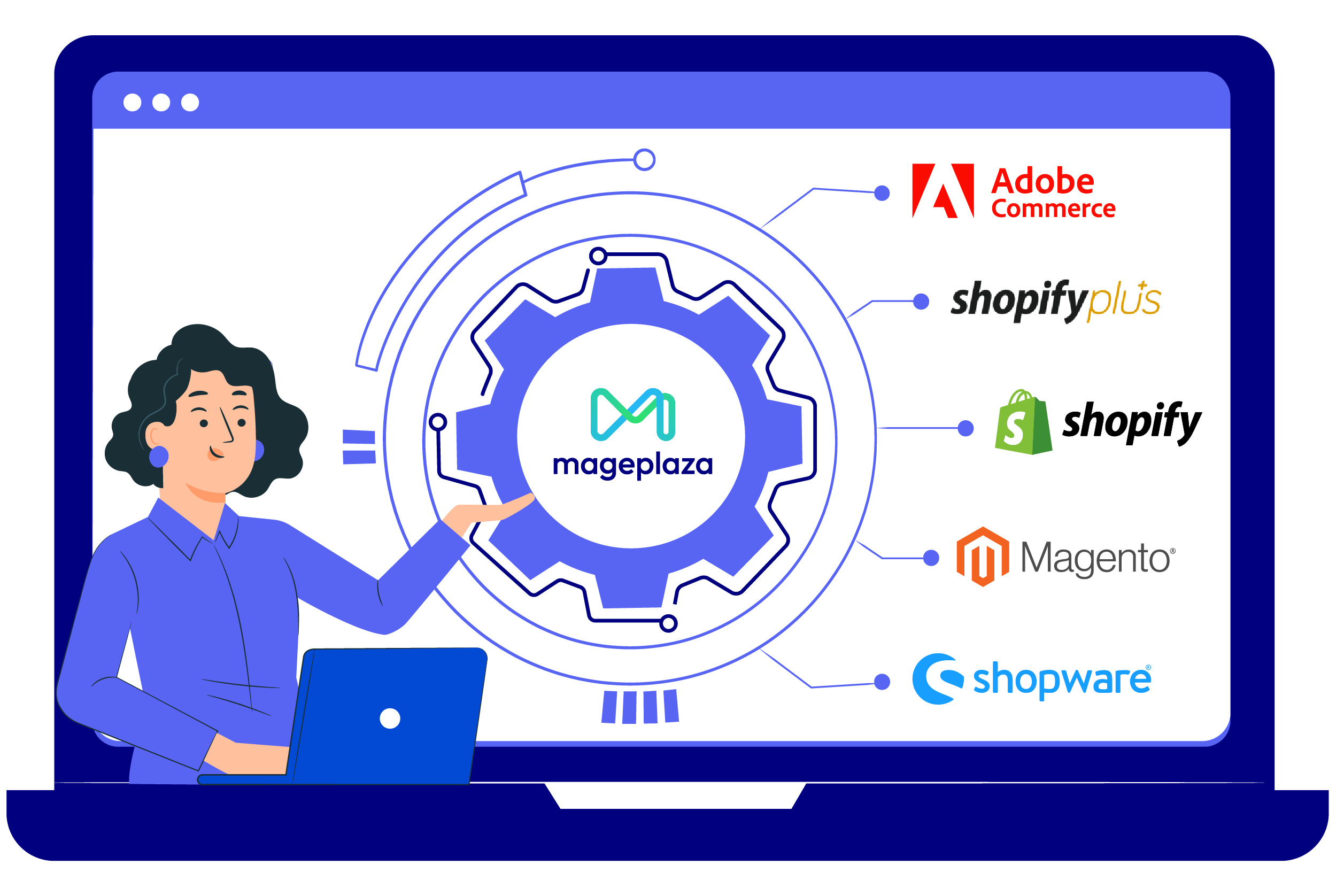Reasons for Low Conversion Rates and How to Improve
Summer Nguyen | 08-29-2023

On online platforms, the conversion rate is a crucial metric determining the success or failure of any digital venture. It can be the percentage of website visitors who take the desired action, whether purchasing, completing providing information through a form or opting in for a newsletter.
A high conversion rate signifies a healthy business with engaged customers and profitable outcomes. The more well-performed your conversion rate does, the less money you have to pay for each sale product and the more successful your online marketing campaign can be.
However, what happens when the conversion rate plummets? This blog post delves into the intricacies of a low conversion rate, addressing its impact and offering strategies to turn the tide.
What is a low conversion rate?
A low conversion rate is when a relatively small percentage of website visitors or users perform the desired action or conversion goal. The result could vary depending on the specific objectives of a website, such as making a purchase, subscribing to a service, downloading a file, or completing a form.
According to NotifyVisitors, “the average website conversion rate is 2.35% across all industries”. For instance, if a website has 1,000 visitors in a given period and only 2 make a purchase, the conversion rate would be 1.2% (12/1,000).
In this case, a low conversion rate would indicate that a significant portion of the website’s traffic is not converting into desired actions, resulting in missed opportunities for generating revenue or achieving specific goals.
A low conversion rate can have various implications for an online business, including reduced profitability, limited customer engagement, and hindered growth. It indicates that barriers or inefficiencies in the user journey or website design may prevent visitors from taking the desired actions. These inefficiencies often overlap with reasons for low sales, such as poor customer experience or ineffective marketing strategies.
Understanding and addressing the factors contributing to a low conversion rate is essential for businesses to optimize their online presence, increase customer engagement, and ultimately improve the overall success of their digital ventures.
Why is a low conversion rate frustrating?
A low conversion rate can frustrate businesses for several reasons:
-
Wasted resources: Businesses invest significant time, effort, and money into driving traffic to their website or marketing campaigns. When the conversion rate is low, many of those resources do not result in desired outcomes. This can feel like wasted opportunities and inefficient resource allocation.
-
Unrealized potential: A low conversion rate indicates untapped potential in converting visitors into customers or achieving the desired actions. It can be frustrating to know that there are prospects who are interested in the offerings but are not taking the desired steps, resulting in missed opportunities for growth and revenue.
-
Impact on profitability: A low conversion rate directly impacts a business’s profitability. Without a sufficient number of conversions, revenue generation is limited, and it becomes challenging to achieve financial goals. This can hinder business growth, investment opportunities, and overall success.
What is a healthy conversion rate?
A healthy conversion rate can vary depending on the industry, business model, and specific goals of a company. There is no universally applicable answer to determining a healthy conversion rate, as it can differ greatly across different businesses and sectors.

In general, a healthy conversion rate is one that is considered competitive within your industry and aligns with your business objectives. It is typically higher than the average conversion rate in your industry and demonstrates effective marketing and sales strategies.
To determine a healthy conversion rate for your business, it is important to analyze industry benchmarks, track your own historical data, and set realistic goals based on your specific circumstances and objectives. Additionally, regularly monitoring and optimizing your conversion rate is essential to continuously improve your performance and stay competitive in the market.
Understanding average ecommerce conversion rates can help businesses gauge their performance relative to industry benchmarks. These rates can vary significantly based on factors such as country, device, and industry. Here’s an overview:
By country
| Country | Average Conversion Rate (%) |
|---|---|
| United States | 2.57% |
| United Kingdom | 3.83% |
| Germany | 2.22% |
| Canada | 2.60% |
| Australia | 2.12% |
By Device
| Device Type | Average Conversion Rate (%) |
|---|---|
| Desktop | 3.90% |
| Mobile | 1.82% |
| Tablet | 3.49% |
By Industry
| Industry | Average Conversion Rate (%) |
|---|---|
| Fashion & Accessories | 2.20% |
| Electronics | 1.44% |
| Home and Garden | 1.84% |
| Health and Beauty | 2.62% |
| Food and Beverage | 2.73% |
It’s important to note that these figures are subject to change based on market dynamics, technological advancements, and consumer behavior trends. Businesses should use these benchmarks as a starting point and strive for continuous improvement through optimization and personalization strategies to enhance their conversion rates.
Why is your conversion rate low?
A low conversion rate can be a frustrating challenge for online businesses. Understanding the reasons behind it is crucial for making targeted improvements and increasing the effectiveness of your website.
Here are some common factors that can contribute to a low conversion rate:
Lack of persuasive and targeted content.
One of the reasons your conversion rate may be low is due to a lack of persuasive and targeted content on your website. In accordance with Forbes, misguided objectives are 1 of the 8 most common mistakes in a marketing campaign. Here are some key aspects to consider:
-
Inadequate product or service descriptions: If your website does not provide clear and compelling descriptions of your products or services, visitors may not fully understand their value or how they can benefit from them. Without persuasive content that highlights the unique features, benefits, and solutions your offerings provide, visitors may hesitate to make a purchase or take the desired action.
-
Lack of relevant and engaging content: To engage visitors and encourage conversions, your website needs to provide valuable and relevant content that addresses their needs, pain points, and interests. If your content is generic, lacks depth, or fails to resonate with your target audience, visitors may perceive your website as unhelpful or irrelevant, resulting in a low conversion rate. Here are 7 effective content strategies you can check out.
-
Absence of social proof: Testimonials, reviews, case studies, and endorsements from satisfied customers are powerful forms of social proof that can instill trust and confidence in potential customers. If your website lacks social proof, visitors may be hesitant to engage with your brand or make a purchase, as they have no evidence of others’ positive experiences.
Read more: User-Generated Content: Definition, Types, Examples & Strategies
Limited or ineffective use of conversion optimization techniques
Conversion optimization involves systematically improving your website’s performance in terms of converting visitors into customers. Your conversion rate may suffer if you’re not actively employing conversion optimization techniques. Here are some key aspects to consider:
- A/B testing: A/B testing, also referred to as split testing, enables you to compare various versions of your website or specific elements to identify which one produces superior outcomes. By testing variations of headlines, call-to-action buttons, layouts, or images, you can identify what resonates best with your audience and drives higher conversions.

-
Heatmap analysis: Heatmap analysis visually represents how visitors interact with your website. It shows you which areas of your pages receive the most attention, where visitors click, scroll, or hover. By understanding user behavior, you can optimize your website’s layout, placement of important elements, and overall user experience to drive conversions.
-
Conversion funnels: Mapping out your conversion funnels allows you to identify potential drop-off points in the customer journey. By analyzing the steps visitors take before converting, you can pinpoint areas of improvement and optimize the flow to minimize friction and increase conversions.
E-commerce Solution Provider
Over 119,000 global clients have achieved their goals with Mageplaza's help. It's your opportunity to do the same now!
Get StartedIneffective targeting
One of the reasons your conversion rate may be low is due to ineffective targeting in your marketing campaigns. Here are some key aspects to consider:
-
Irrelevant audience: If your marketing campaigns are not reaching the right audience, you may attract visitors with little interest or need for your products or services. These visitors are less likely to convert because they are not the target market you intended to reach. As a result, your conversion rate is negatively impacted.
-
Poorly defined target audience: If you haven’t clearly defined your target audience, you may struggle to create marketing messages that resonate with their needs and preferences. Lacking a comprehensive understanding of your target customers, you may attract a broad range of visitors who are not suitable for your offerings, leading to a low conversion rate.
-
Inaccurate audience segmentation: Effective audience segmentation is essential for delivering personalized and relevant marketing messages. If your audience segments are not accurately defined or you are targeting too broad or too narrow, your marketing efforts may fail to connect with the right individuals. This can result in a low conversion rate as visitors may not feel the content is tailored to their specific needs.
You can also check out this method by using psychology in web design to track down the factors that decreased your conversion rate more productively.
5 Methods to Boost the conversion rate on your website
Optimizing conversion is not a matter of implementing random actions; it requires having a standard “framework” to measure the outcomes. This “framework” comprises:
1. Clearly defined goals
Establish specific and measurable conversion goals that align with your business objectives.
-
Alignment with business objectives: Your conversion goals should directly support your overall business objectives. This guarantees that your efforts are focused on driving the desired outcomes that contribute to your business growth. For example, if your aim is to increase online sales, your conversion goal could be to drive a specific number of completed purchases.
-
Specific and measurable: Your conversion goals should be clear and measurable in order to facilitate tracking progress and evaluate success. Avoid vague goals like “increase conversions” and instead set specific targets such as “increase email sign-ups by 20% within three months.”

-
Relevant to your target audience: Consider the needs and expectations of your target audience when defining your conversion goals. What actions do you want customer to involve in? What value proposition can you offer to incentivize them to convert? Aligning your goals with your audience’s motivations and desires increases the likelihood of achieving higher conversion rates.
-
Realistic and attainable: While it’s important to set ambitious goals, ensure they are also practical and achievable. Setting unrealistic goals can result in frustration and dissatisfaction. Analyze your historical data, industry benchmarks, and available resources to set goals that are challenging yet achievable.
-
Time-bound: Assign a timeframe to your conversion goals to create a feeling of urgency and accountability. This helps you track progress, identify areas for improvement, and necessary adjustments along the way.
2. Have a clear value proposition for the target audience
-
Understand your target audience: Before creating a value proposition, it’s essential to have a deep understanding of your target audience. Conduct market research, analyze customer feedback, and identify their pain points, desires, and motivations. This understanding will help you tailor your value proposition to resonate with their needs and preferences.
-
Identify your unique selling points: Determine the special features, benefits, or qualities that set your products or services apart from your competitors. What makes your offerings unique? It could be superior quality, affordability, convenience, exceptional customer service, or innovative features. Highlight these USP in your value proposition to differentiate yourself in the market.

-
Focus on benefits, not just features: While mentioning the attributes of your products or services is essential, emphasize the benefits they bring to your customers’ lives. How will your offerings solve their problems or fulfill their desires? Clearly communicate the value they will receive by choosing your brand.
-
Keep it clear and concise: A strong value proposition should be easily understood and quickly grasped by your target audience. Use simple language and avoid technical jargon. Keep it brief, ideally within a sentence or two, to capture attention and maintain interest.
-
Test and refine: Crafting a compelling value proposition may require iteration and testing. Experiment with different messaging, wording, or positioning to identify what appeals most to your intended audience. Monitor the response and feedback from customers, and refine your value proposition based on their preferences and reactions.
3. Conversion tracking and analytics
Set up conversion tracking: Implement conversion tracking tools such as Google Analytics to track specific actions or goals on your website. This could include purchases, form submissions, newsletter sign-ups, or any other desired conversions.
-
Analyze user behavior: Dive deep into user behavior data to perceive how visitors interact with your website. Identify patterns, such as which pages have high bounce rates or where users drop off in the conversion process. This information will help you pinpoint areas that need improvement.
-
Evaluate conversion funnels: Examine the steps users go through from the initial interaction to the final conversion. Identify any bottlenecks or points where users abandon the process. This analysis will help you optimize the flow and remove any barriers to conversion.
-
Track critical metrics: Monitor key metrics such as conversion rate, average order value, time on site, and bounce rate. These metrics provide insights into the effectiveness of your website and specific pages. Regularly assess these metrics to track progress and identify areas that need attention.

-
Utilize data-driven insights: Use the data and insights gathered to make informed decisions and optimizations. For example, if a specific page has a high bounce rate, analyze its content and design to identify potential issues and make improvements. Similarly, if a particular call-to-action consistently performs well, replicate its elements on other pages.
-
Continuously test and iterate: Use A/B testing and other testing methods to experiment with different elements of your website, such as headlines, visuals, forms, or layouts. Analyze the results and iterate based on data-driven findings to continuously improve your conversion rates.
4. Identify the reasons why customers hesitate or are uncertain

-
Conduct customer research: Gain insights into your target audience through customer research, surveys, or interviews. Understand their needs, pain points, and concerns when purchasing. This will help you identify common sources of hesitation or uncertainty.
-
Analyze website data: Dive into your website analytics to gather user behavior and engagement data. Look for patterns or trends that indicate areas where visitors are hesitating or encountering uncertainty. For example, high bounce rates on certain pages or low engagement on key elements could indicate potential issues.
-
Review customer feedback: Pay attention to customer feedback, reviews, and comments to identify recurring themes related to hesitation or uncertainty. Feedback from customer support interactions can also provide valuable insights into customers’ specific challenges.
-
Evaluate website usability: Assess the usability of your website, including navigation, layout, and user interface. A poorly designed or confusing website can create hesitation and uncertainty among visitors. Conduct user testing or utilize heatmaps and session recordings to identify usability issues and make necessary improvements.
-
Improve trust signals: Build trust with your audience by incorporating trust signals throughout your website. This can include customer testimonials, reviews, security badges, trust seals, or industry certifications. Communicate your value proposition and demonstrate credibility to alleviate customers’ doubts.
-
Address common objections: Identify common objections or concerns that potential customers may have and address them directly on your website. This can be complete through clear and concise product descriptions, FAQ sections, or dedicated pages addressing specific concerns. Anticipate and overcome objections to instill confidence in your offerings.
-
Optimize communication channels: Ensure that your communication channels, including live chat, email, or phone support, are readily available and responsive Promptly address customer inquiries or concerns to alleviate any uncertainties during decision-making.
5. Conduct A/B testing
-
Identify the goal: Determine the specific conversion goal you want to focus on for your A/B test. It could be increasing click-through rates, improving form submissions, or enhancing purchase conversions.
-
Select the element to test: Choose the specific feature on your website or landing page that you want to test. It could be the headline, call-to-action button, layout, color scheme, or any other element that you believe could impact conversions.
-
Create variations: Develop different versions of the selected element. For example, if you’re testing a call-to-action button, create two or more variations with additional text, colors, or sizes. Each variation represents a different version of the element you want to test.
-
Split your audience: Divide your website visitors into separate groups and randomly assign them to different variations. For example, if you have two variations, you can split your audience equally between them. This ensures that each group represents a fair sample of your general audience.
-
Run the experiment: Display the different variations to their respective audience groups simultaneously. It’s essential to run the test for a sufficient duration to collect statistically significant data. This assures that the results are reliable and not influenced by random fluctuations.
-
Measure and analyze results: Track and measure the performance of each variation against your conversion goal. Analyze the data collected during the test period and determine which variation performed better in terms of achieving the desired conversion. This analysis typically involves statistical significance calculations to ensure the results are reliable.
-
Implement the winning variation: If one variation outperforms the others significantly, implement it as the new default version on your website or landing page. This winning variation represents the optimized version that drives higher conversions.
-
Repeat and iterate: A/B testing is an ongoing process of continuous improvement. Once you have implemented the winning variation, continue testing and optimizing other elements on your website or landing page to enhance conversions further.
Conclusion
In conclusion, low conversion rates can significantly impact a business’s success. Conversions are crucial for generating revenue, acquiring customers, and achieving business objectives. A low conversion rate indicates missed opportunities and inefficiencies in the sales and marketing process.
Conversion rates are crucial indicators of marketing effectiveness and website performance. A high conversion rate signifies successful strategies, optimized website design, and engaged customers.
By focusing on improving conversion rates, businesses can unlock their full potential, increase customer acquisition, boost revenue, and stay competitive in the ever-evolving digital landscape. It’s a strategic imperative for businesses to prioritize conversion rate optimization and continuously strive for better results to achieve their goals and drive sustainable success.






![Top 20+ Must-have Shopify Apps for 2025 [Free & Paid] - Mageplaza](https://cdn2.mageplaza.com/media/blog/must-have-shopify-apps/top-must-have-shopify-apps.png)
![[2025 Updates] Top 10+ Upsell Apps for Shopify - Mageplaza](https://cdn2.mageplaza.com/media/blog/best-upsell-shopify-app/cover.png)